The Gundestrup Cauldron, one of the most remarkable archaeological finds from the Celtic world, is an ancient silver vessel that offers a fascinating glimpse into the spiritual and cultural practices of the Celts. Discovered in 1891 in a peat bog in Gundestrup, northern Jutland, Denmark, the cauldron is now housed in the Danish National Museum in Copenhagen. Its intricate designs and depictions of Celtic gods, rituals, and armies make it an invaluable artifact, shedding light on the beliefs and traditions of the Celts during the Iron Age. Follow archeology.dulichvn.net to learn more about mysterious artifacts.
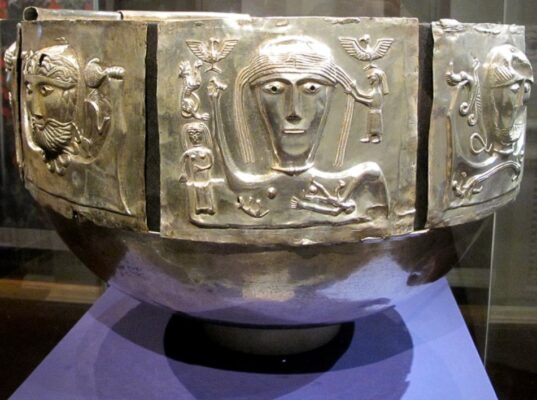
Discovery of the Gundestrup Cauldron
The Peat Bog Find
The Gundestrup Cauldron was discovered in 1891 in a peat bog near the town of Aars in northern Jutland, Denmark. Peat bogs have long been a source of well-preserved ancient artifacts, and this discovery was no exception. The cauldron was buried deep in the bog, which helped preserve its silver surface and intricate carvings for centuries.
Uncovering a Celtic Treasure
When the cauldron was found, it was initially mistaken for a religious or ceremonial vessel used by the Celts. The remarkable preservation of the artifact and the richness of its imagery made it one of the most important archaeological finds in northern Europe. Its discovery sparked considerable interest in the study of Celtic art, religion, and society.
The Location and Its Significance
The cauldron’s location in northern Jutland, near the ancient trade routes of the Celts, is significant. This region was known for its strong Celtic presence during the Iron Age, and the find adds to our understanding of the complex cultural interactions between the Celts and other ancient civilizations. The cauldron likely held important religious or ceremonial value, further highlighting the spiritual practices of the Celts.
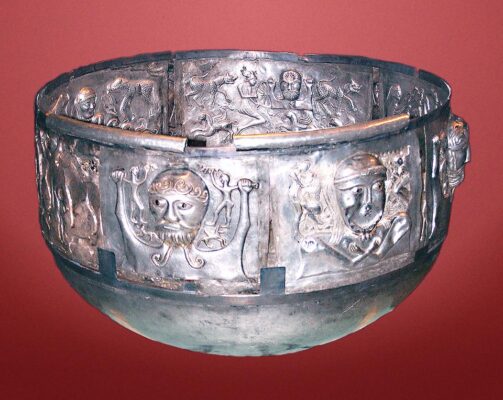
The Design and Imagery of the Gundestrup Cauldron
Depictions of Celtic Gods: Cernunnos
One of the most striking features of the Gundestrup Cauldron is the detailed carvings of Celtic gods, most notably Cernunnos, the horned god. Cernunnos is depicted with antlers, a symbol of fertility, nature, and the cycle of life. His portrayal on the cauldron signifies his importance in Celtic religion and suggests that the cauldron may have been used in rituals connected to nature and fertility.
The Human Sacrifice Scene
Another powerful image on the cauldron is that of a human sacrifice, a practice that was part of some ancient Celtic rituals. This scene depicts a figure being sacrificed to the gods, possibly to ensure prosperity, protection, or a bountiful harvest. The presence of such a scene on the cauldron underscores the importance of ritual and sacrifice in Celtic religious practices.
Depictions of Armies and Warfare
The cauldron also features detailed depictions of an army on foot and mounted on horses. These scenes reflect the military prowess of the Celts and their warrior culture. The presence of such imagery suggests that the cauldron may have had a dual function: both a religious vessel and a symbol of Celtic strength and unity in battle.
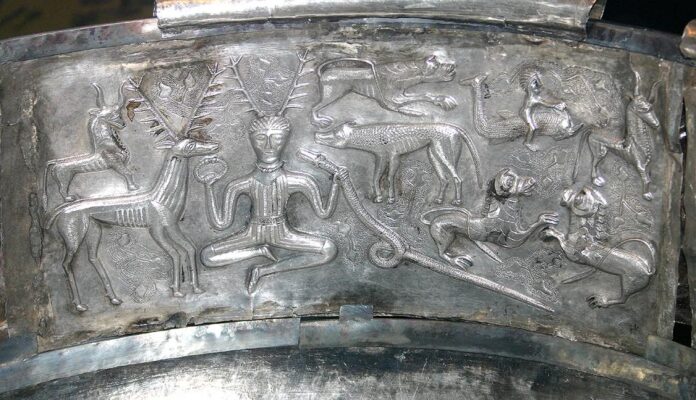
The Gundestrup Cauldron’s Historical and Cultural Significance
A Reflection of Celtic Society
The Gundestrup Cauldron is not just a work of art; it is a window into the worldview and beliefs of the Celts. The detailed carvings on the cauldron offer insights into Celtic mythology, religion, and social structure. The inclusion of deities, warriors, and rituals suggests that the Celts had a complex belief system that blended nature worship, warrior culture, and ancestor veneration.
A Symbol of Celtic Craftsmanship
The cauldron is a masterpiece of Celtic craftsmanship, showcasing the skill of the artisans who created it. The use of silver, along with the intricate designs and detailed engravings, demonstrates the high level of artistry in Celtic metalwork. The cauldron’s elaborate decoration and fine craftsmanship make it a testament to the technical and artistic abilities of the Celts during the Iron Age.
Its Role in Celtic Rituals and Ceremonies
Given the scenes depicted on the Gundestrup Cauldron, it is likely that the vessel played a role in Celtic religious rituals or ceremonies. The images of gods, sacrifices, and warfare suggest that the cauldron may have been used in ceremonies designed to honor deities, ensure military success, or mark important life events such as births or harvests.
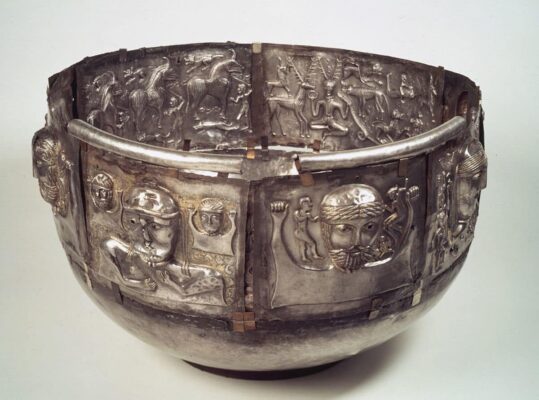
The Gundestrup Cauldron Today
Display at the Danish National Museum
Today, the Gundestrup Cauldron is housed in the Danish National Museum in Copenhagen, where it continues to be one of the most important pieces in their collection. The cauldron is displayed alongside other significant Celtic artifacts, providing a comprehensive view of Celtic culture and religion. Visitors to the museum can marvel at the cauldron’s intricate designs and learn about its historical context.
Ongoing Research and Study
The Gundestrup Cauldron remains the subject of ongoing research and study by archaeologists and historians. Scholars continue to examine the cauldron to gain a deeper understanding of its origins, purpose, and the significance of its depictions. Some believe the cauldron may have been a diplomatic gift, while others argue that it was created for use in local rituals. Regardless of its exact purpose, the cauldron remains an invaluable artifact that offers new insights into the ancient world.
A Lasting Legacy
The Gundestrup Cauldron’s legacy as one of the most important Celtic artifacts endures to this day. It continues to captivate audiences with its stunning craftsmanship and the mysteries it holds about the Celtic world. As one of the few surviving examples of Celtic religious and ceremonial art, the cauldron provides a lasting connection to the distant past, ensuring that the culture and beliefs of the Celts are not forgotten.
See more: The Temple of Esna: A Masterpiece of Ancient Egyptian Architecture
Conclusion: The Enduring Mystery of the Gundestrup Cauldron
The Gundestrup Cauldron is an extraordinary artifact that offers invaluable insights into the spiritual and cultural practices of the Celts. Its discovery in 1891 has had a lasting impact on the study of Celtic history, and its intricate carvings continue to fascinate scholars and visitors alike. Housed in the Danish National Museum, the cauldron remains a symbol of Celtic craftsmanship, mythology, and the rich traditions of an ancient civilization.

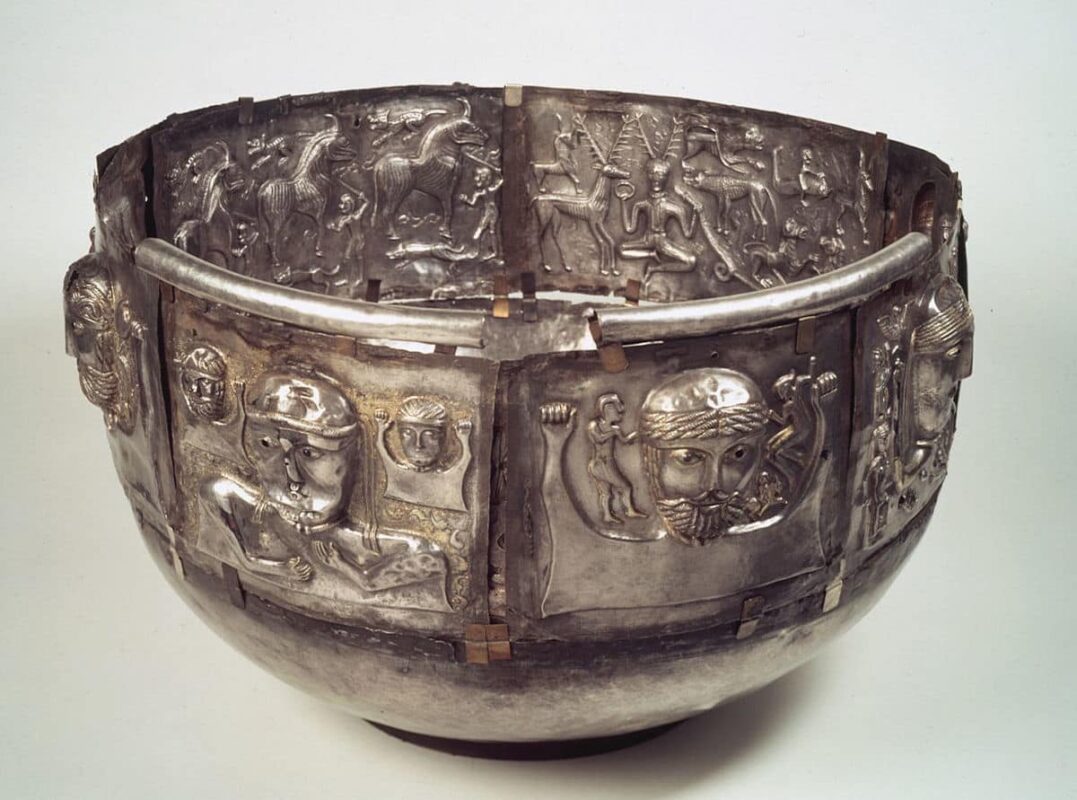
CÁC TIN KHÁC
Mary Walton: The Forgotten Inventor Who Helped Clean Up America’s Cities
Tomb of Queen Nefertari in the Valley of the Queens, Egypt
Discover the Hypostyle Hall of the Temple of Hathor at Dendera
Venus de Losange: Unveiling the Mystery of a 20,000-Year-Old Paleolithic Icon